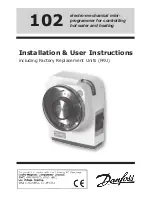
page
20
.
Shapes available at present are Circle, Square, Diagonal 1, Diagonal 2, Angles, Inf.ty, Zigzag.
Parameters at operators’ disposal at present are:
X_SCL: scale on the X axis (from 0 to 100%)
Y_SCL: scale on the Y-axis (from 0 to 100%)
SPEED: speed at which the effect is run (from 0 to 255)
ROTAT: direction of movement (normal or inverse)
ANG: starting angle of the movement (from 0 to 359).
By using the scale and speed parameters, the initial figures can be deformed, thus creating
others.
Fixtures using effects controlled via the joystick or the cursors cannot be positioned: the move-
ment effects in fact operate on the entire scanning area. To run an effect in any given point, the
SCANNING AREAS must be used (see parag. 7.5.3). When running the same effect on several
scanners, using the ANG parameter allows to create spectacular “chase” effects: this parameter in
fact creates a delay between the various fixtures which visually appears as a delay time in running
the movements. Some movement effects achieve the maximum spectacularity when the fixtures
used are installed in a regular or symmetric layout.
7.4 Use in Reg mode
In the same way as the Light Chase Control section, Scan Control can also be used in two modes:
Direct (see 7.1) and Reg.
Reg mode operates directly on the memory registers and allows to carry out the necessary varia-
tions directly in the register without having to reconstruct the register’s entire contents (which as
we already comprise dimmer channels, chases and programs). This is possible thanks to the
logic software used: the memory register’s components operate together in the register, but can
be separately modified, as they are separate “entities”.
It’s therefore possible to modify the running times of a program added to a Memory Register by
just latching it to the REG command: just press the
button and hold it down. One of the 12
Memory Register LEDs will flash, showing that the operator is using that particular register. To
select another, just press the relative button.
In this way, running parameters (Rate, Speed, Music and Bckward) can be modified and it’s also
possible to decide which fixtures and effects to use in that particular register. Selection is carried
out in the same way as in DIRECT mode (see 7.1.1.). A program can be added to several memory
registers with all the required variations: it’s thus possible to have the same number of variations
as there are memory registers available.
The only limit is in the program’s essence: if a scene is modified, all the registers will have the
scene modified. A scene realized with certain effects is therefore the essence of the program and
if it’s decided to leave out a scene in register X, the program isn’t modified, only how it runs.
7.5 – The Utilities
To facilitate operators’ work to the utmost, some functions have been grouped together in menus,
which can be accessed by pressing the
button. The fundamental utilities will appear on the
u t i l
reg
SHAPE X_SCL Y_SCL SPEED ROTAT ANG
static --- --- --- ----- ---
















































